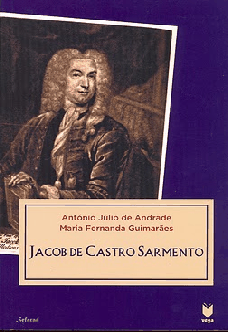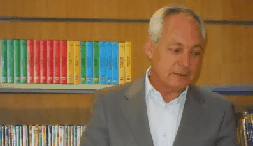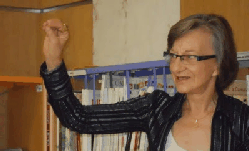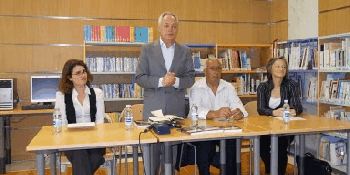

THE
INCREDIBLE
STORY OF THE JEWISH PEOPLE
Dr. Castro Sarmento
(1691-1761)
A pioneer of the smallpox vaccine and a quinine water remedy ("Aguas da Inglaterra")
__________________________________
On Sunday, June 13, 2010, His Worship, António Jorge Nunes, the mayor of Braganza launched a new biography called .. The son of Francisco de Castro Almeida and Violante da Mesquita, Marranos from Braganza who was baptized Henrique in Braganza in 1691.
Welcomed into the Sephardic fold of Bevis Marks congregation in London after fleeing the Portuguese Inquisition, Sarmento became the first Jew to obtain a PhD in the UK and one of the first Jews to be admitted to the Royal College of Physicians.
A pioneer of the smallpox vaccine and a quinine water remedy ("Aguas da Inglaterra"), Sarmento was one of many "Bragantinos" to distinguish themselves in the Marrano diaspora
Dr Castro Sarmento (1691-1761)
a Portuguese Marrano in England
by A. Andrade and F. Guimaraes
PREFACE
by
PROFESSOR MICHAEL ALPERT
President of the Jewish Historical Society of England.
 Visitors to the Spanish and Portuguese synagogue, built in 1701 in Bevis Marks towards the eastern side of the historic City of London, can see, on tablets fixed to the walls around the ladies’ gallery, lists of parnassim or lay leaders of the congregation, elected annually ever since its foundation in 1656, when a few Portuguese Jews, nominally Catholics, received tacit permission to worship as Jews and buy ground for a cemetery.
Visitors to the Spanish and Portuguese synagogue, built in 1701 in Bevis Marks towards the eastern side of the historic City of London, can see, on tablets fixed to the walls around the ladies’ gallery, lists of parnassim or lay leaders of the congregation, elected annually ever since its foundation in 1656, when a few Portuguese Jews, nominally Catholics, received tacit permission to worship as Jews and buy ground for a cemetery.
Throughout the centuries, these names were almost always Portuguese or Spanish. Even today, when most members of the Congregation are not descended from the refugees from the Inquisition who founded it, ceremonial synagogue announcements are still made in Portuguese. For example, a certain person ‘abrirá as portas do hekhal’, that is will receive the honour of opening the doors of the Ark in which the scrolls of the Hebrew Pentateuch are kept. As the authors of this book recall, on the annual Day of Atonement (kippur) the liturgy includes a prayer for ‘todos nossos irmãos prezos pela Inquisição’ ( ‘All our brothers imprisoned by the Inquisition’). The Spanish and Portuguese Jews’ Congregation is indeed very conscious of its history. Liturgical practice changes rarely, while the internal architecture of the synagogue in Bevis Marks has scarcely changed since it was built by refugees from the Inquisition.
All Spanish Jews were expelled in 1492, unless they accepted Christian baptism. The Inquisition was already investigating the genuineness of the Christianity of Jews who had been baptised over the previous two or three generations. Secret Judaism in Spain was rapidly crushed, leaving only occasional foci. Tens of thousands of Jewish exiles fled Spain over the frontier to Portugal, but there in 1497 all Jews were forcibly baptised, without the option of exile. However no Inquisition was established in Portugal until 1536, which allowed 39 years for the well-developed secret practice of Judaism among a relatively large section of the population to become firmly established and, despite the Inquisition, to remain undiscovered in some parts of the country until the twentieth century.
For the Inquisition, the observance of Jewish customs and law by New Christians, as baptised Jews and their descendants were known, was a heresy which had to be investigated and punished. Braganza was a centre of this ‘judaizing heresy’. The subject of this book, Doctor Henrique, later Jacob, Castro Almeida, later Castro Sarmento, was one of those Portuguese crypto-Jews who fled the Inquisition and came to London in the early 18th century.
The history of the Spanish and Portuguese Jews in London has been studied, but this book tells us about some of the early members of the Congregation from the Portuguese side, and uses the very rich sources of the Inquisition itself. The authors have scoured the archives of the Portuguese Inquisition for details of people who came to London, particularly the family from which Castro Sarmento sprang. His family was prey to the Inquisition for three hundred years. His ancestor Francisco Rodrigues, a notary of Braganza, was arrested in 1541, soon after the Holy Office was introduced into Portugal, while his distant descendant João de Castro, a weaver, was sentenced in 1744. Not long afterwards, like its equivalent in Spain, the Portuguese Inquisition would largely cease to occupy itself with the hunt for secret Jews.
From this book we learn something of what it meant to be a Cristão Novo or New Christian. By the 18th century New Christians were seven or eight generations removed from their Jewish ancestors who had been baptised in 1497. New Christians were often of unimpeachable Catholic loyalty, yet their ancestors might also have taken care to marry other New Christians, making their descendants Jewish according to Jewish law. Refugees might be observers of the laws of Judaism to the extent of what was possible in the alien atmosphere of the Iberian Peninsula. Yet others, like Castro Sarmento himself, though he was one of 92 New Christians denounced to the Inquisition by a fellow-physician, may or may not have been practising Judaism but were sufficiently close to those who did to be at risk of imprisonment and interrogation by the Inquisition.
Like so many secret Jews, young Doctor Henrique de Castro Almeida took a Jewish forename - Jacob - and a new patronymic - Sarmento - when he reached London in 1721, at the height of the Inquisition’s last and very fierce campaign to eradicate the heresy of judaizing. Elected a Fellow of the Royal Society in 1729, Dr. Castro Sarmento was a brilliant physician, particularly in the fields of inoculation against smallpox and in developing quinine and commercializing it as Agoas de Inglaterra (English Waters).
As one sits in the ancient synagogue in London, one finds oneself wondering what arriving in that strictly controlled Jewish community must have been like for people whose previous lives - however much Judaism they tried to practise - had been Catholic, as was the case for everyone in Spain and Portugal. How did Castro Sarmento deal with the dietary laws and those of the Sabbath and the Festivals of the Jewish year ? How did he follow the Hebrew liturgy? We can perhaps obtain a glimpse from reading the sermon he wrote for the Day of Atonement, as well as one or two other religious compositions. Yet in the end he left the Jewish world. After his wife’s death he married a non-Jewish woman in Church. This would have required baptism but, since he had already been, like everyone in Portugal, baptised as a Catholic at birth, did the Church of England authorities accept him at least formally as a Christian? Shortly afterwards, in 1758, he resigned from the Synagogue, though his letter to the parnassim merely states that he held different views. He died in 1762.
The authors of this informative book write that they did not go deeply into the details of the trials of people from Braganza who were of Castro Sarmento’s family. This is a task which should be undertaken and would prove enlightening about the Jewish knowledge of the early members of the Portuguese Jews’ Congregation in London and the other places - Amsterdam, Jamaica, and New York - to which the refugees went.
MICHAEL ALPERT
|
|
|
|
|
|
Fernanda Guimarães,
tireless researcher of the
Inquisition archives at the
Torre de Tombo, National Archives. She taught herself German to read the seminal work on Portuguese Marranos in Spain by
Marcus Schreiber,
" Marranen in Madrid 1600-1670" (Stuttgart 1994).
His Worship,
António Jorge Nunes,
mayor of the City of Braganza.
Carla da Costa Viera (left),
PhD student
and author of the preface,
and co-authors
António Júlio de Andrade and
Maria Fernanda


